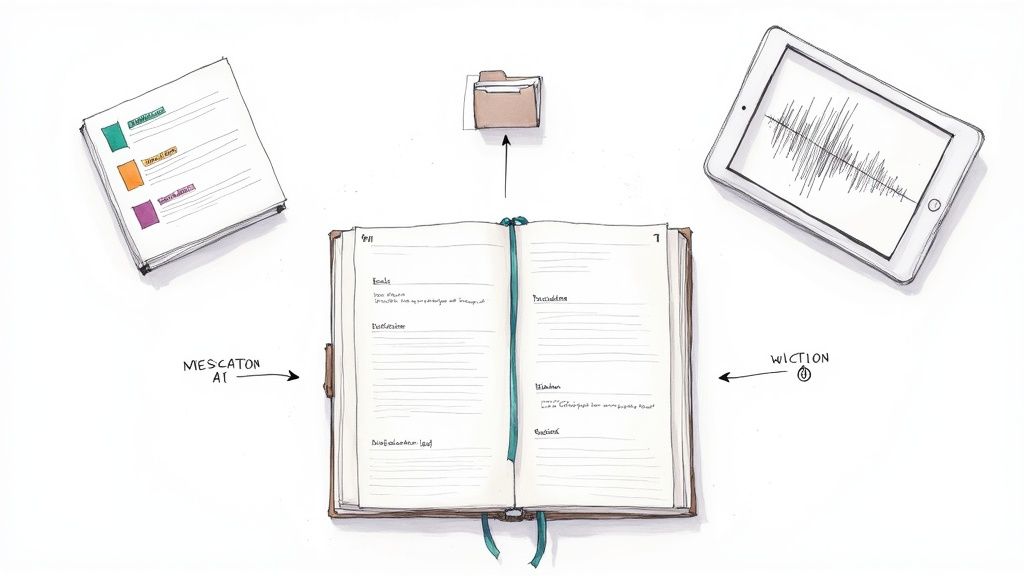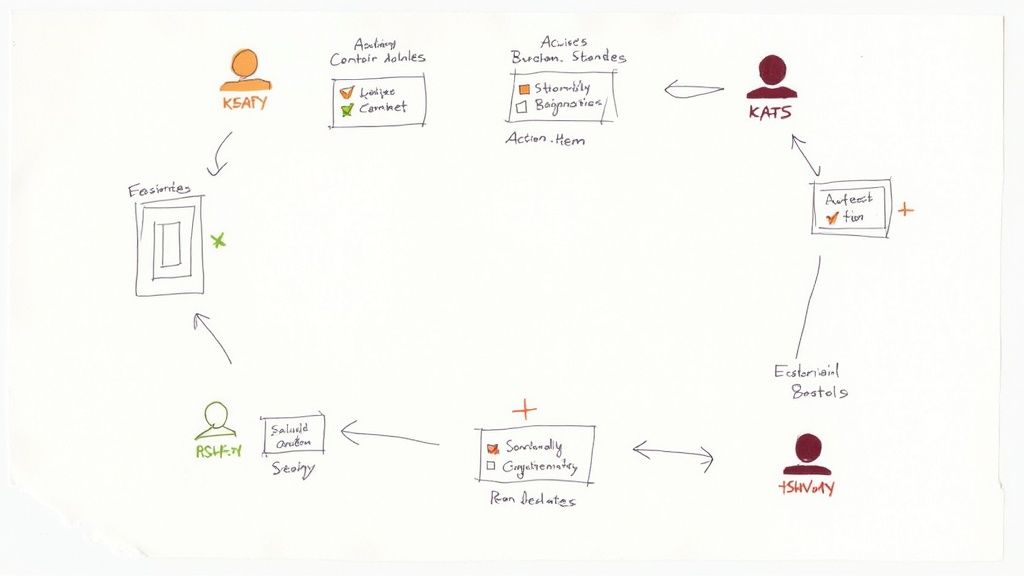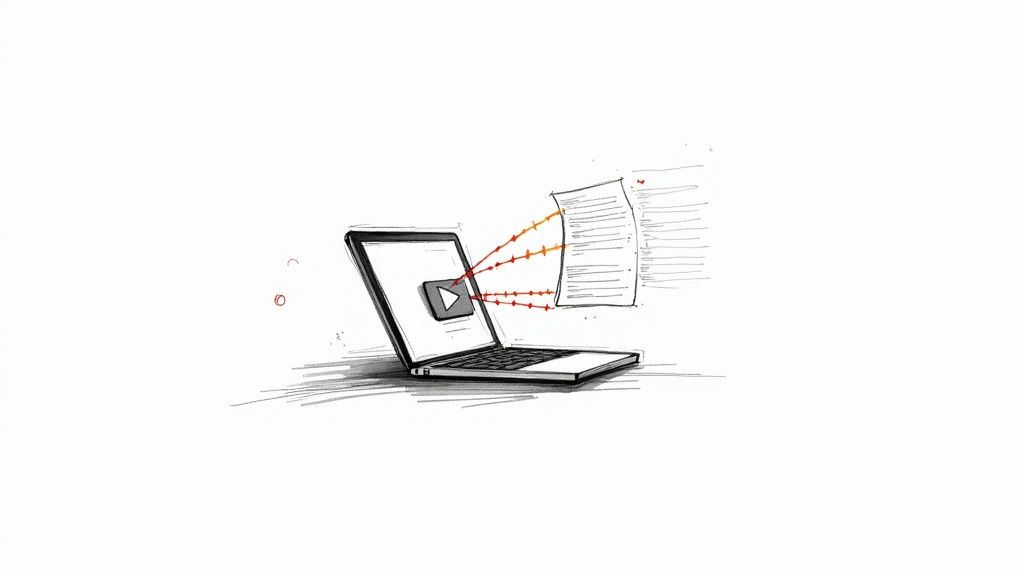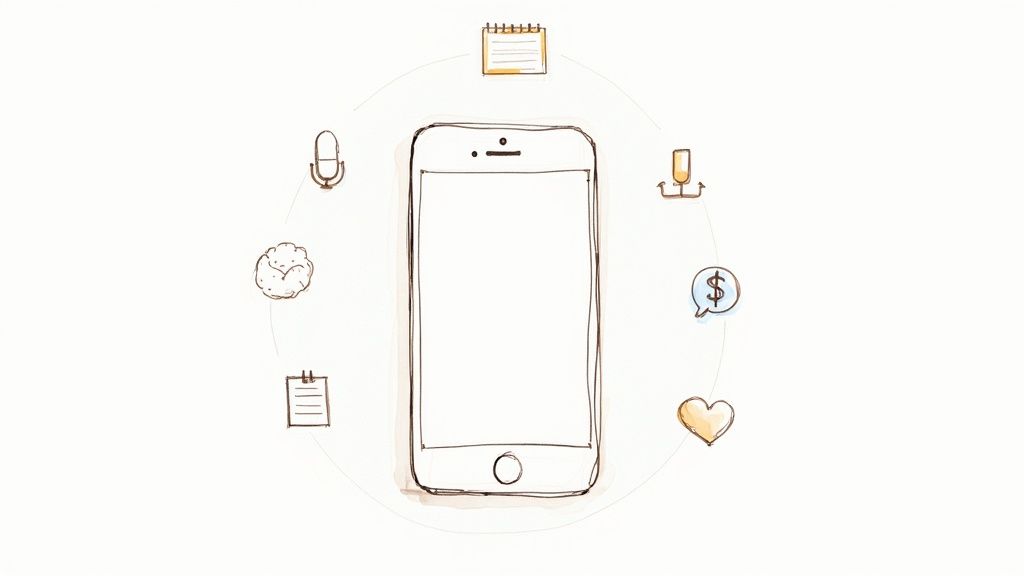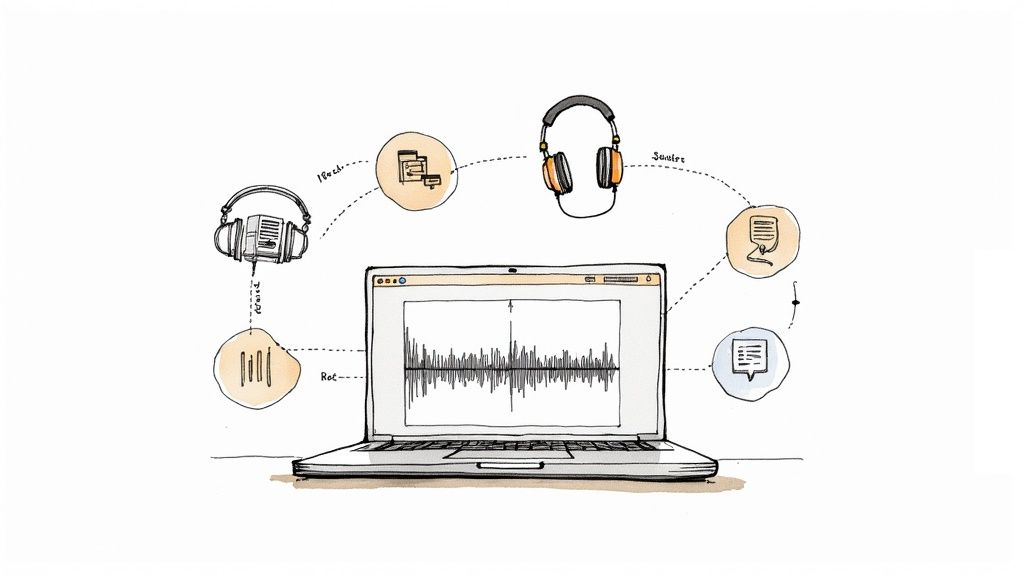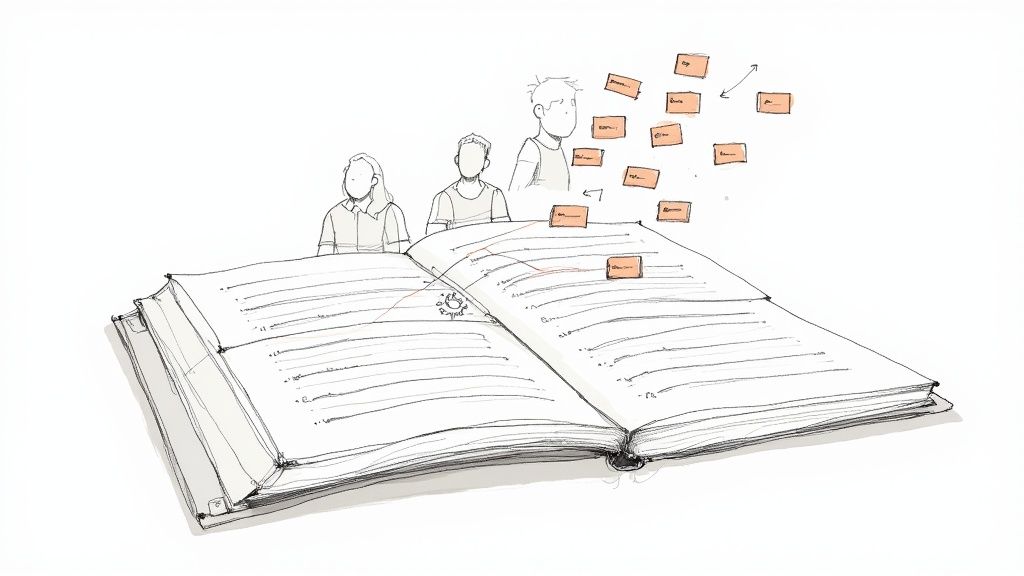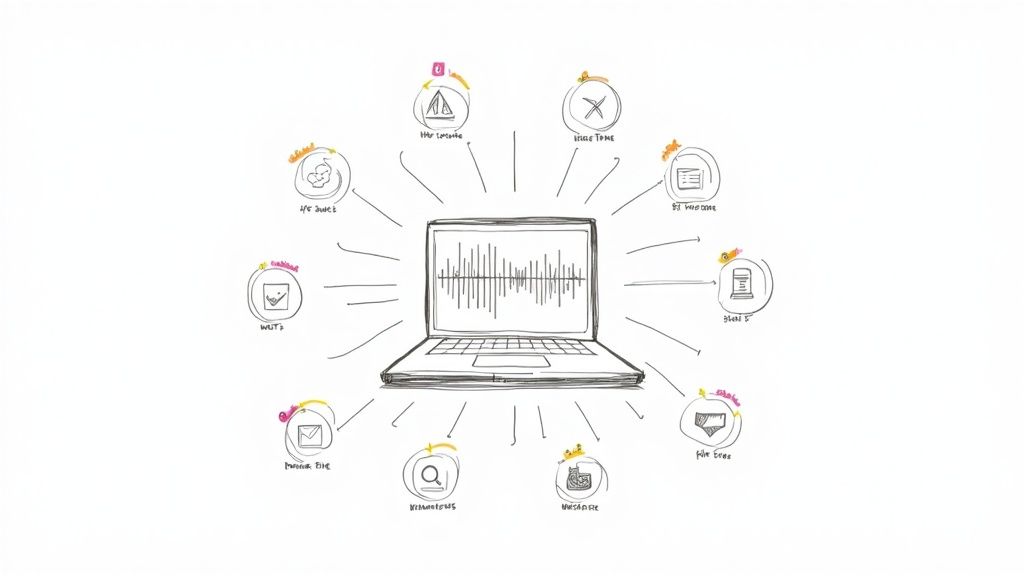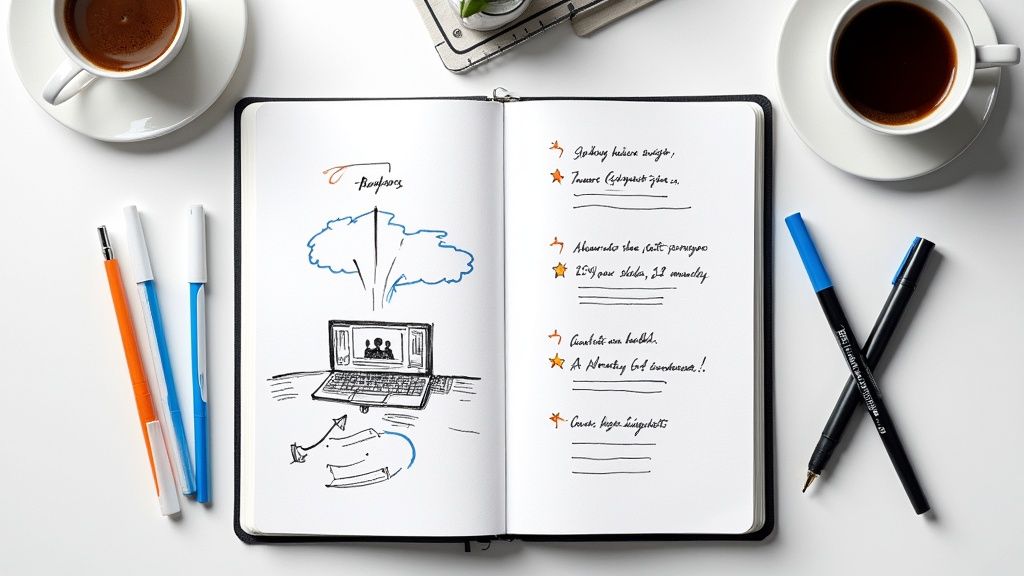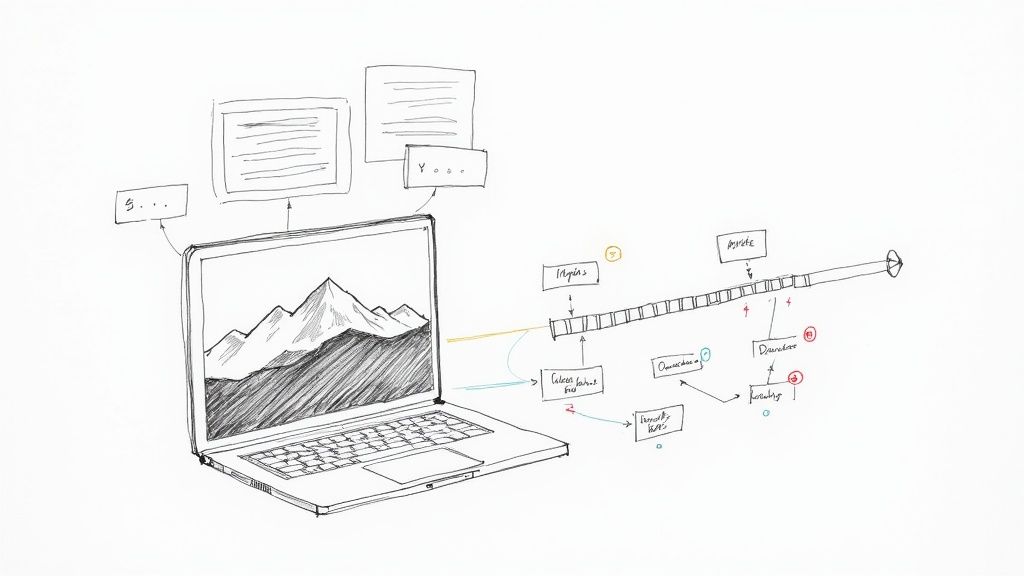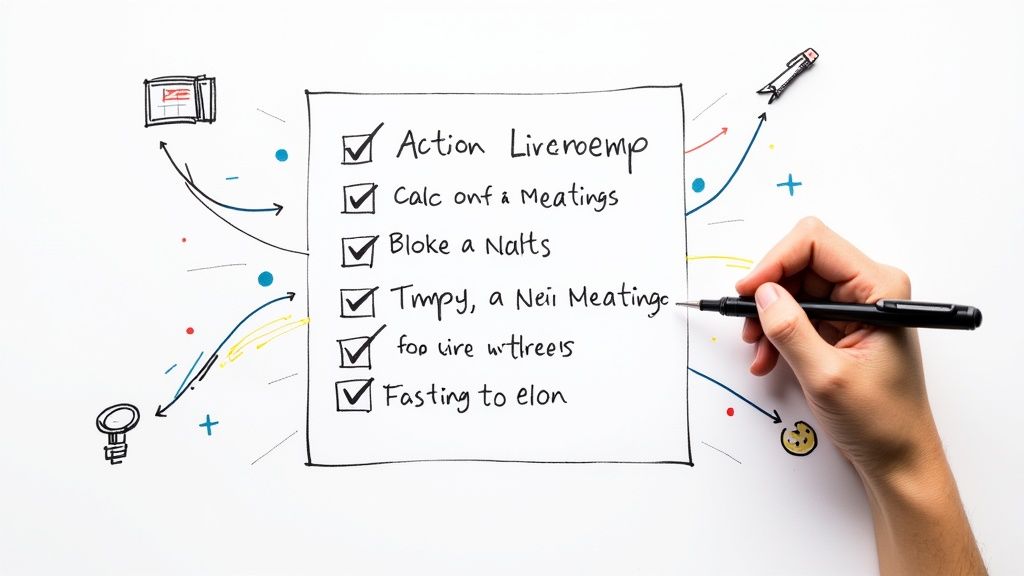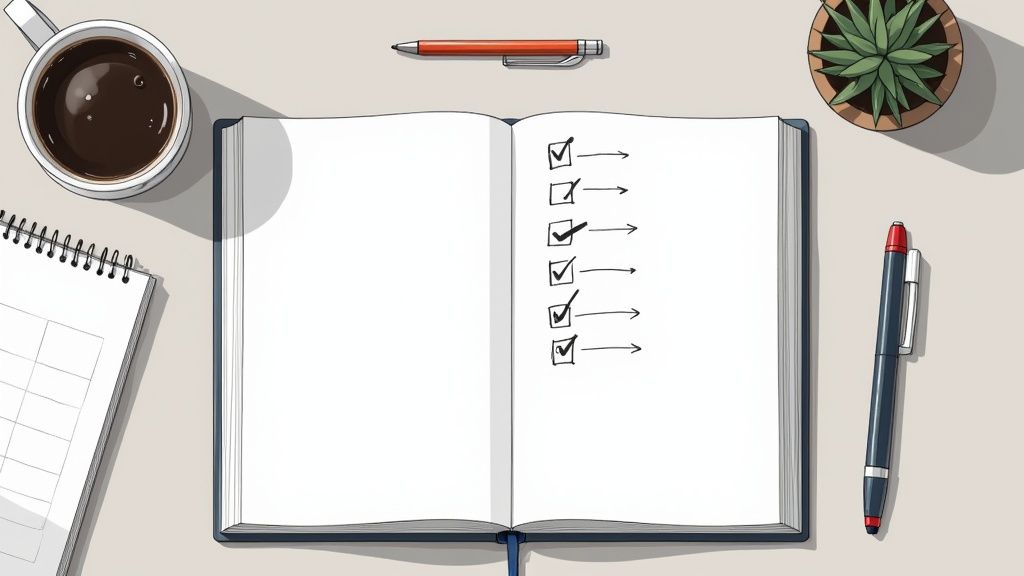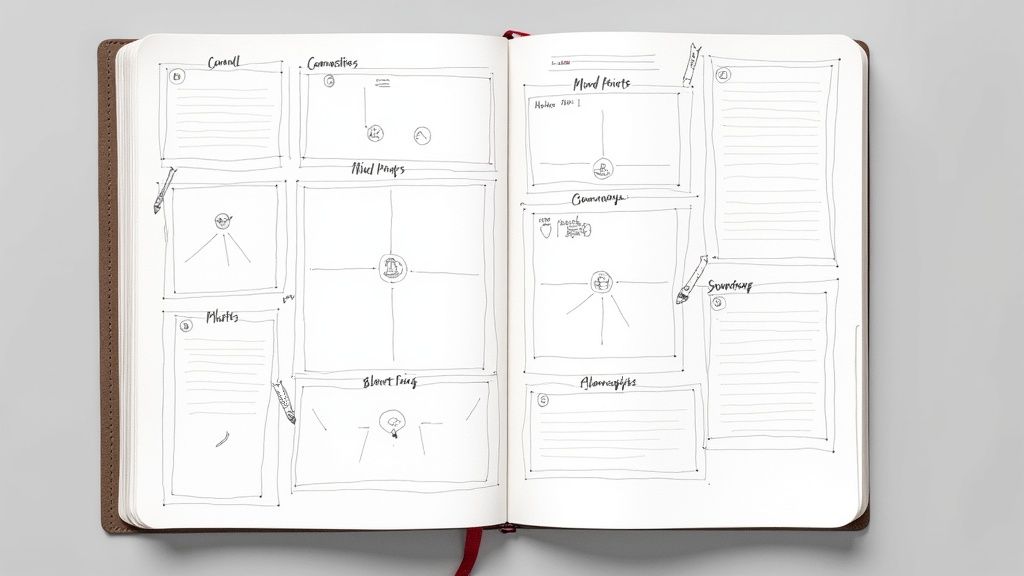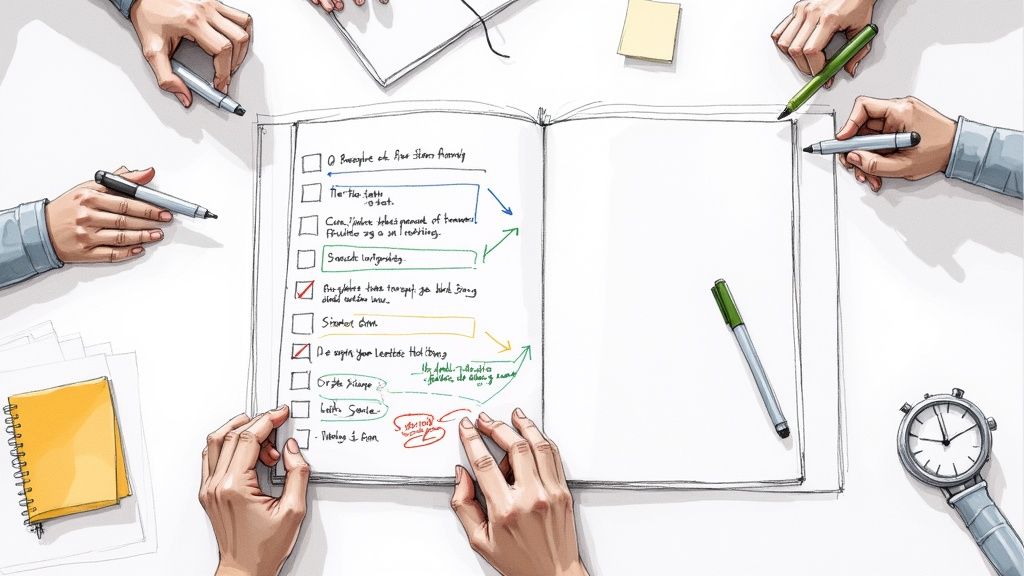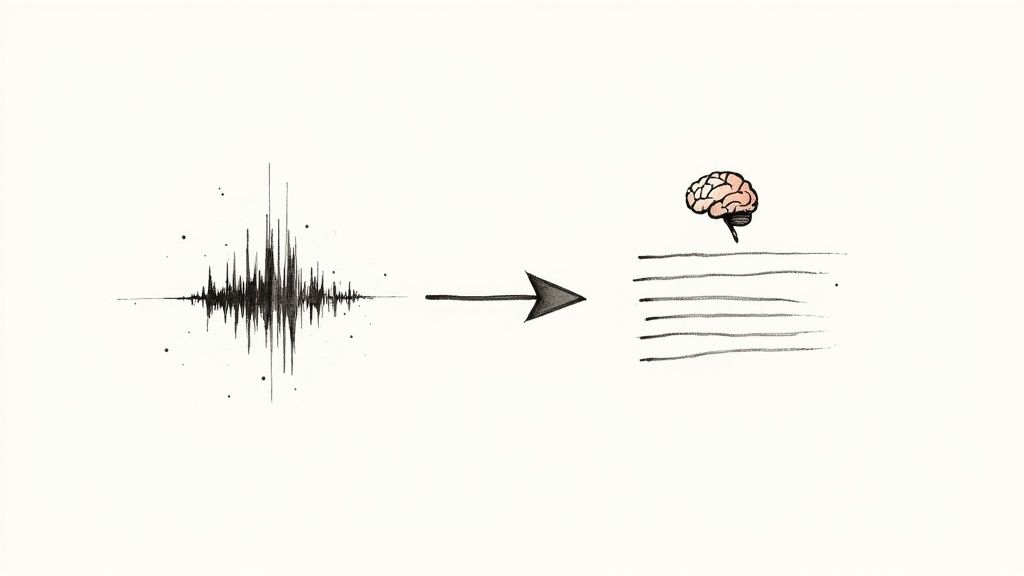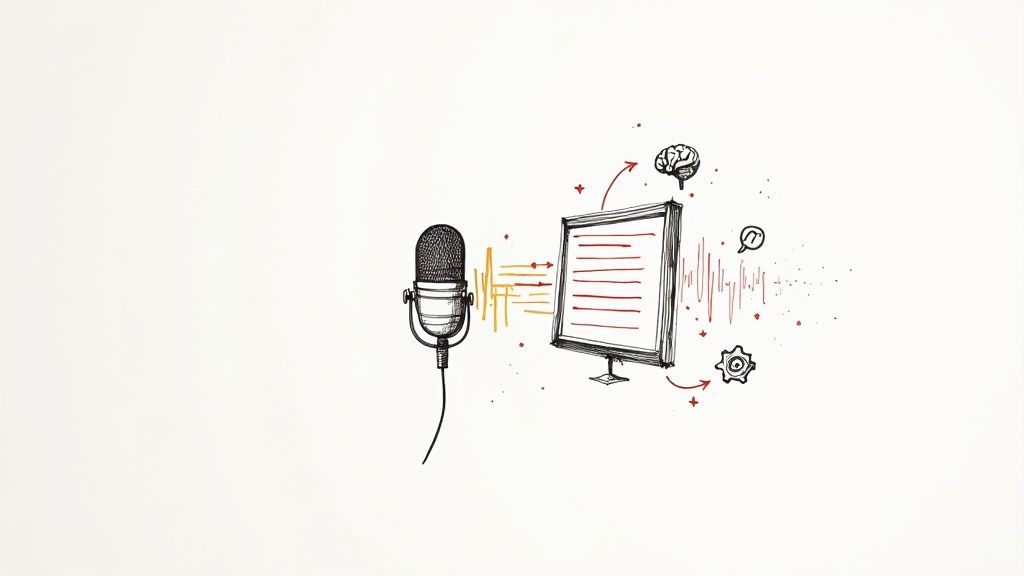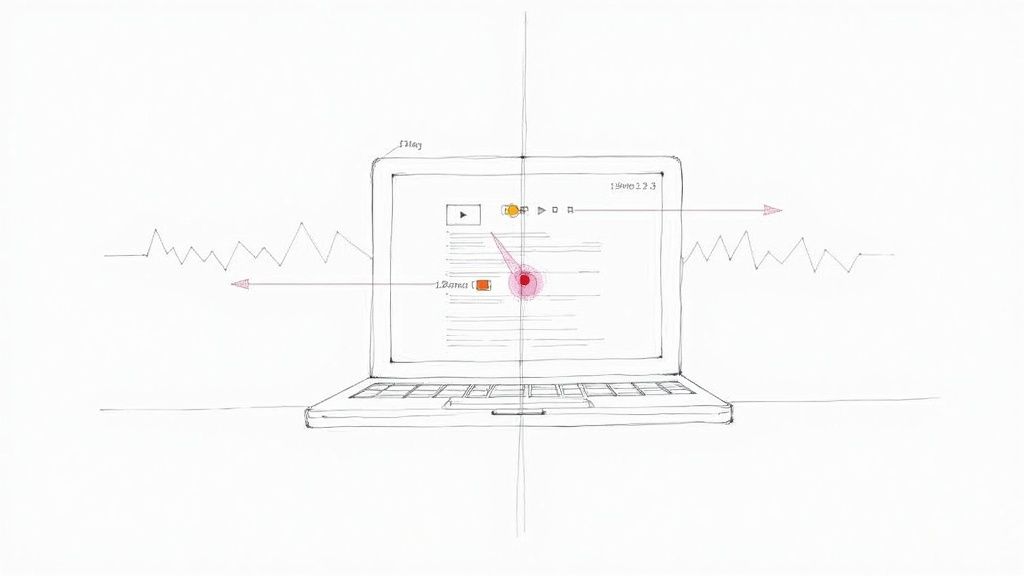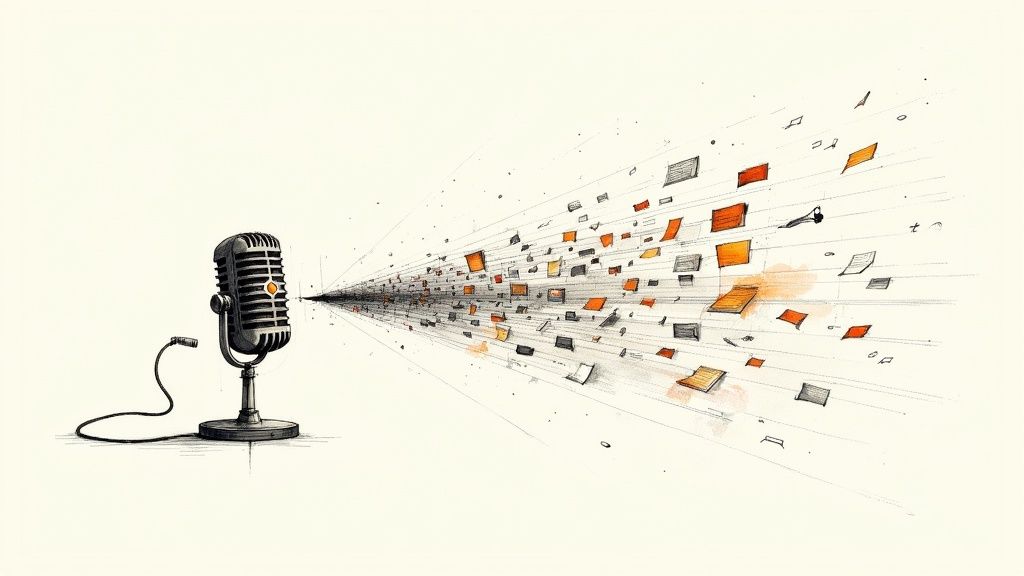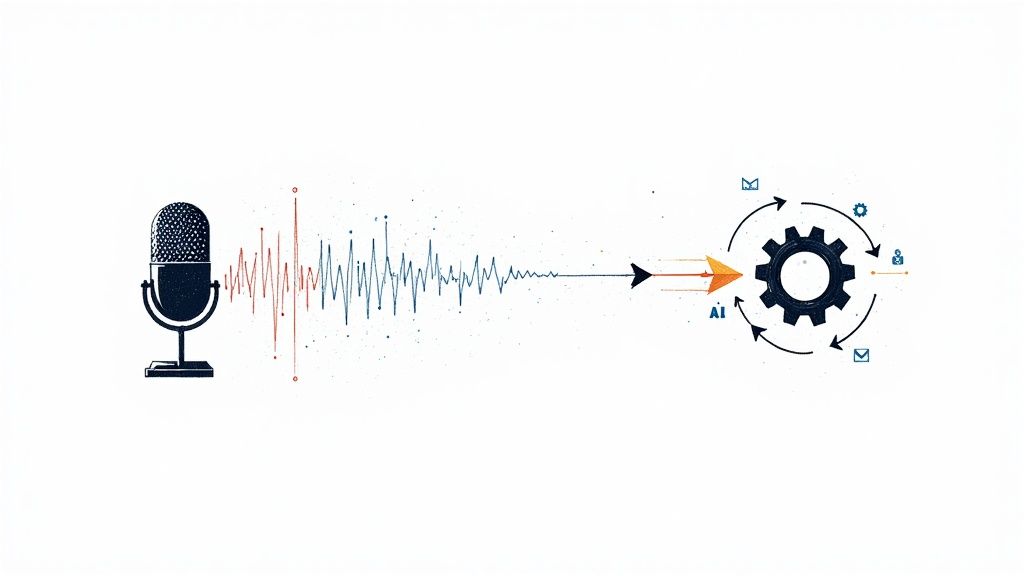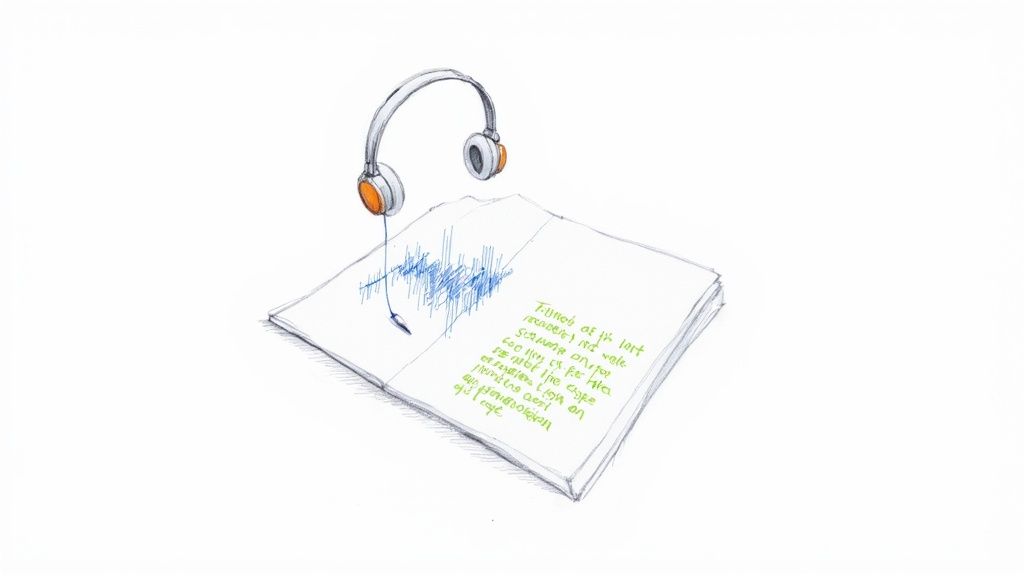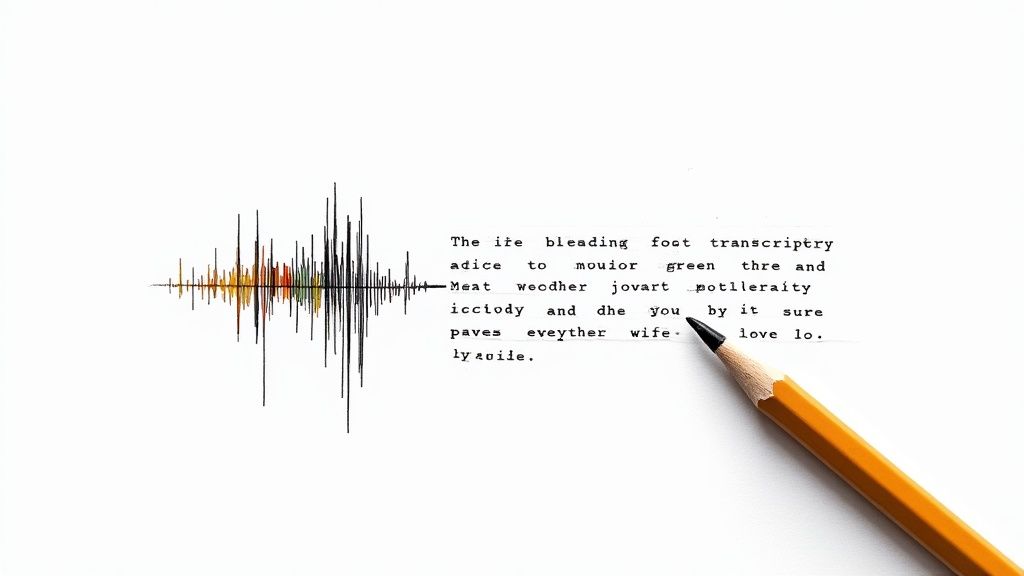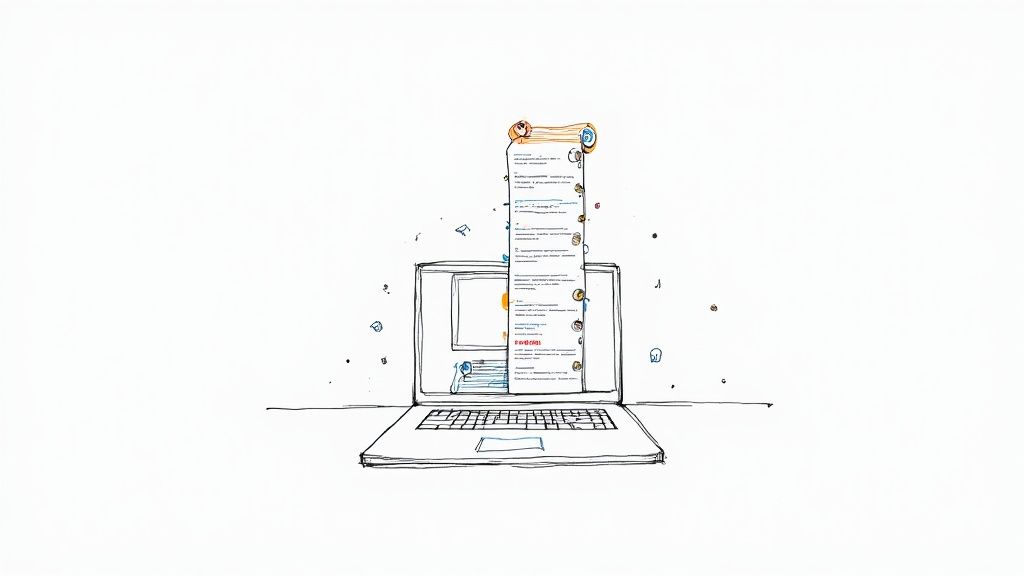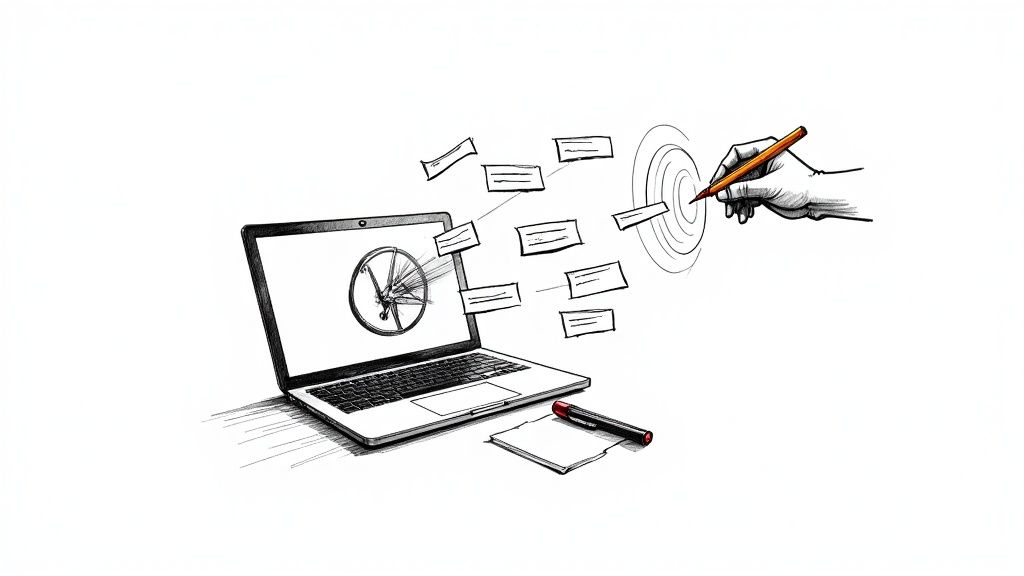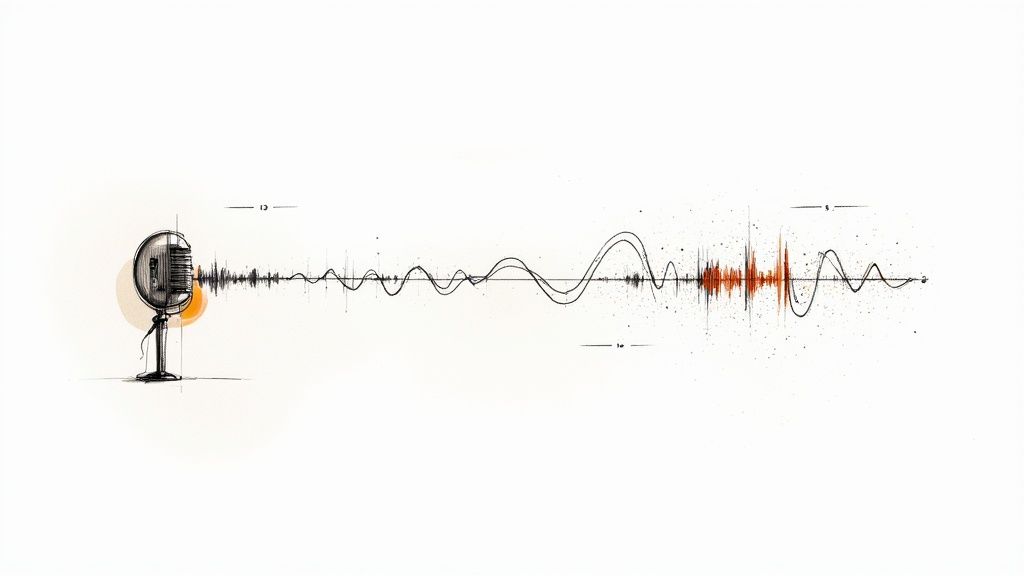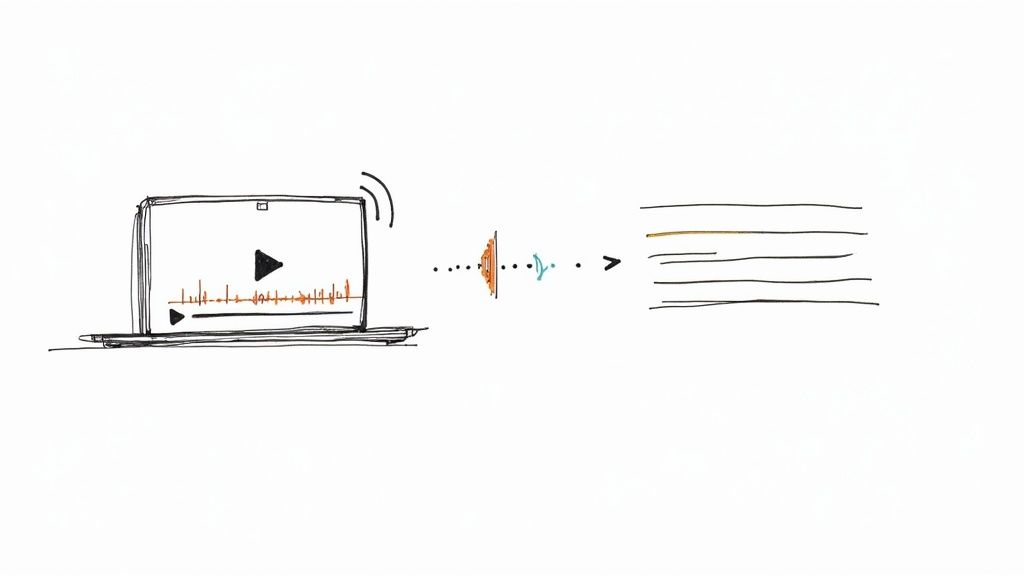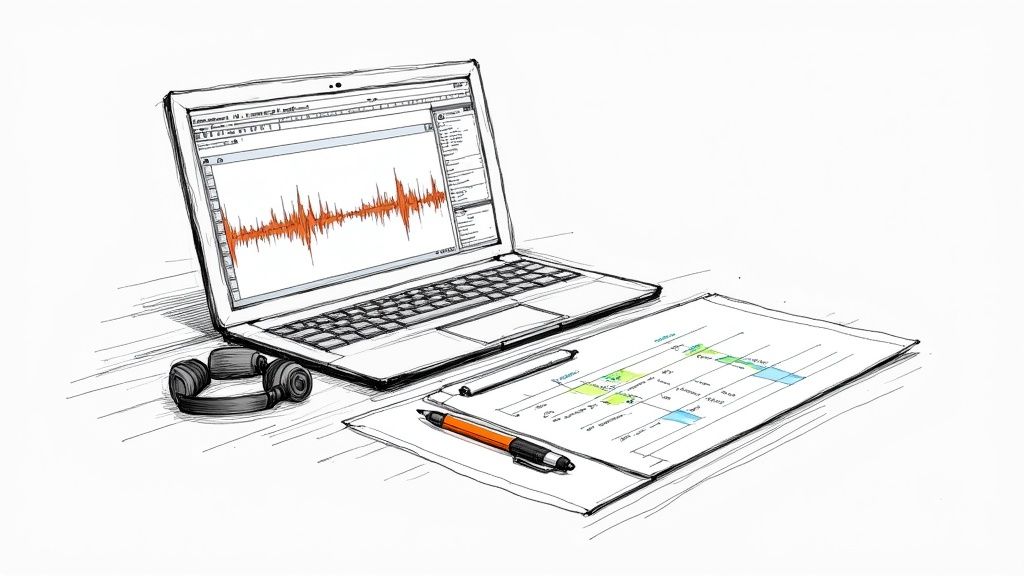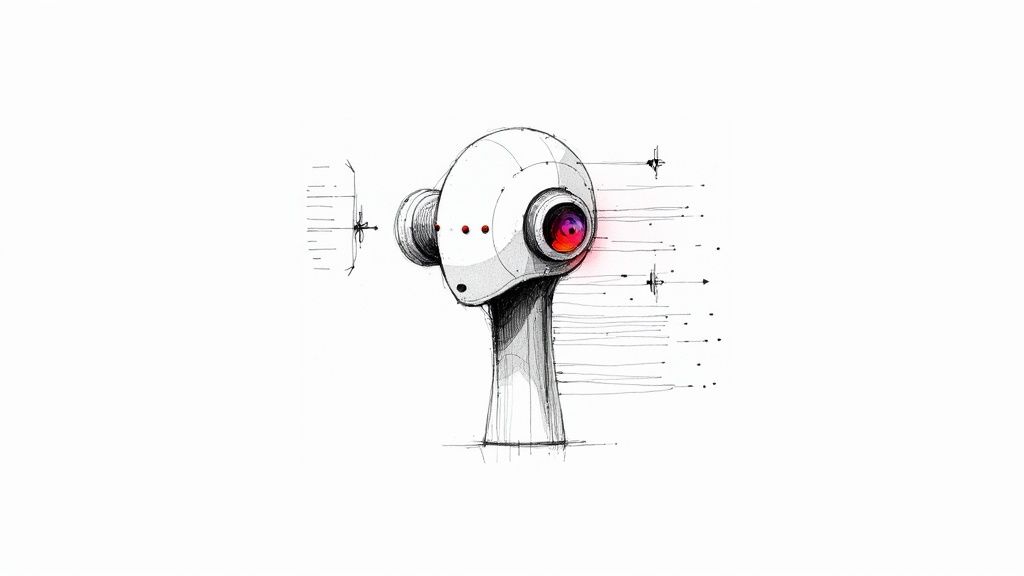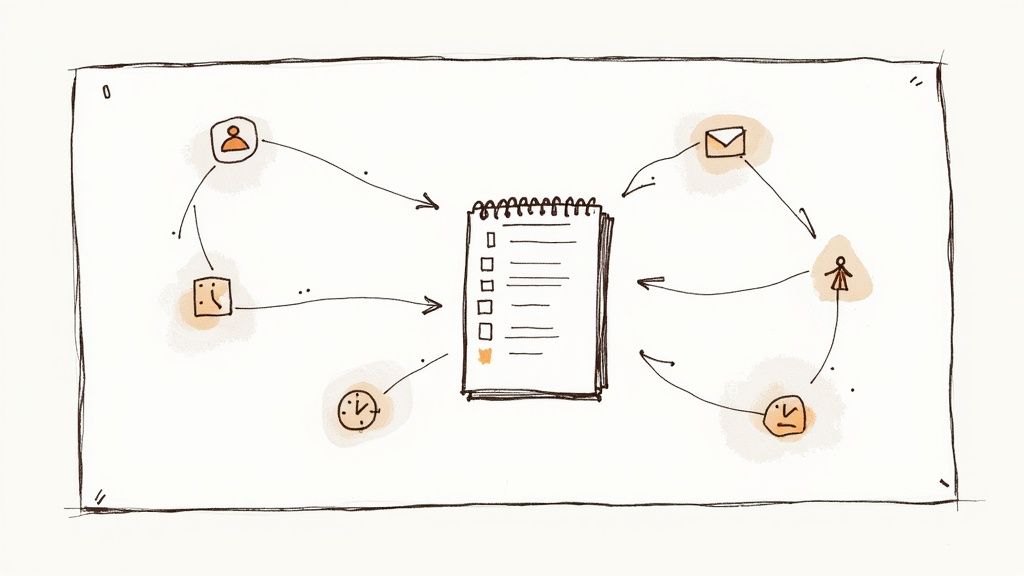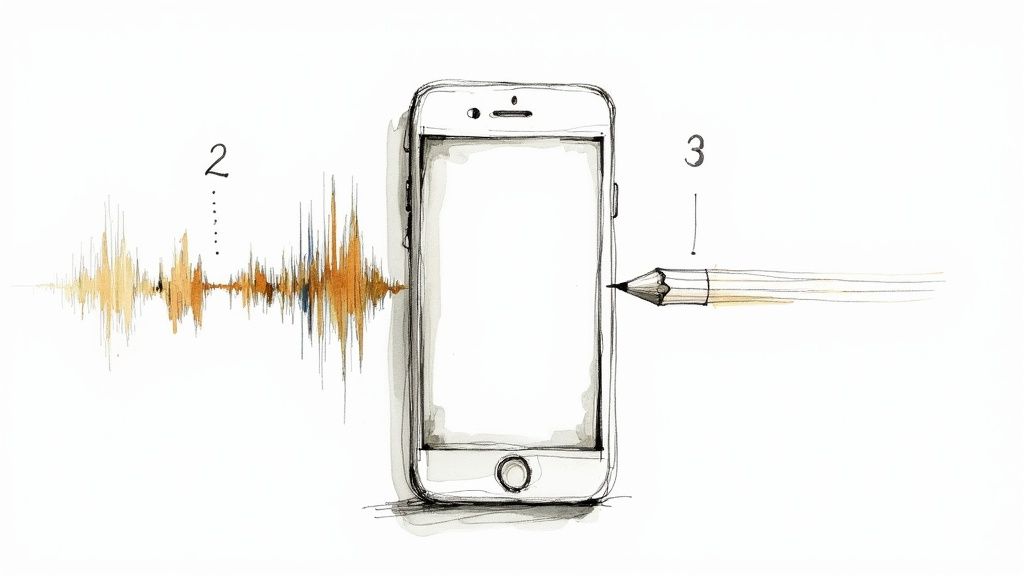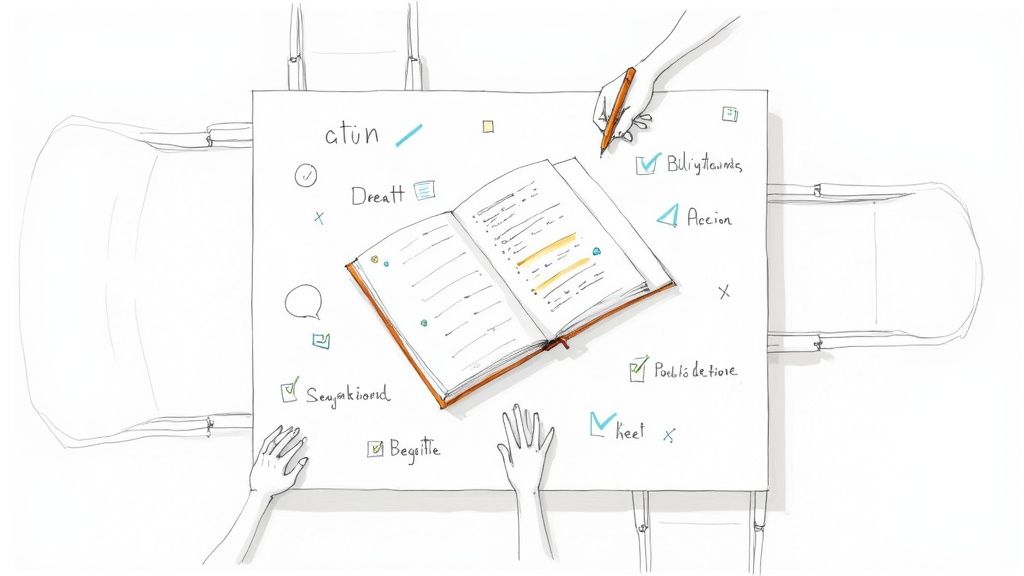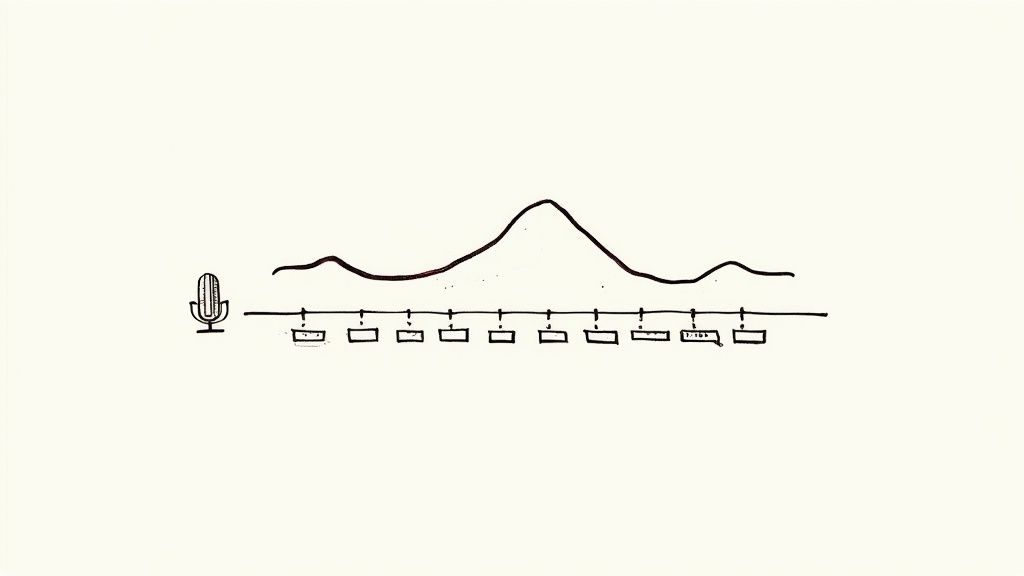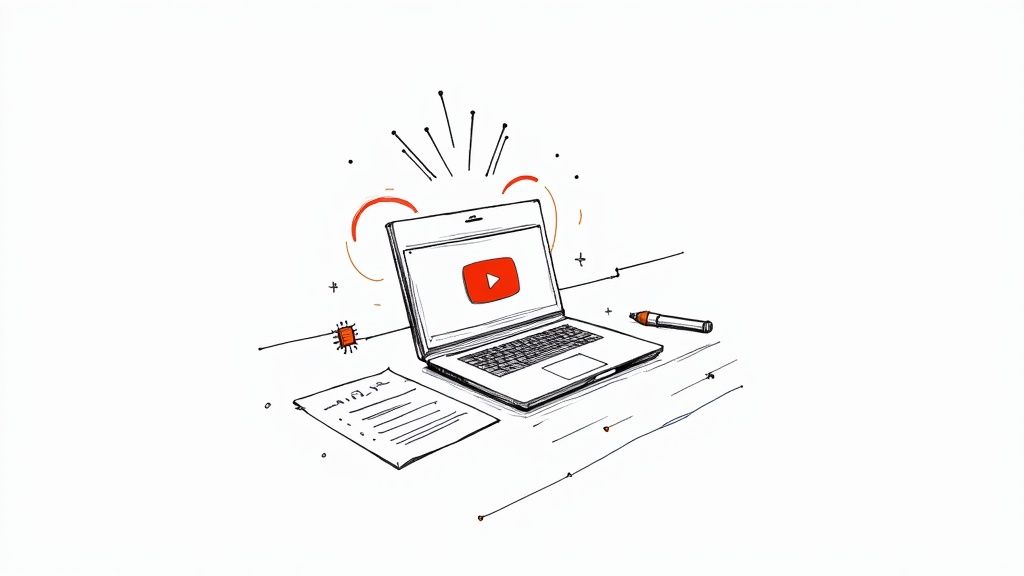
How to Take Interview Notes: A Practical Guide to Better Hiring
The secret to great interview notes isn't what you write down during the interview—it’s the structure you build before it even starts. When you walk into a conversation with a plan, you’re set up to capture objective, evidence-based details, not just a gut feeling about the candidate. This means preparing specific questions tied directly to the job’s core needs, deciding on your note-taking method, and always getting consent to record.
This guide will walk you through a proven process for taking interview notes that are clear, consistent, and genuinely helpful for making the right hiring decision.
Building a Framework for Effective Notes
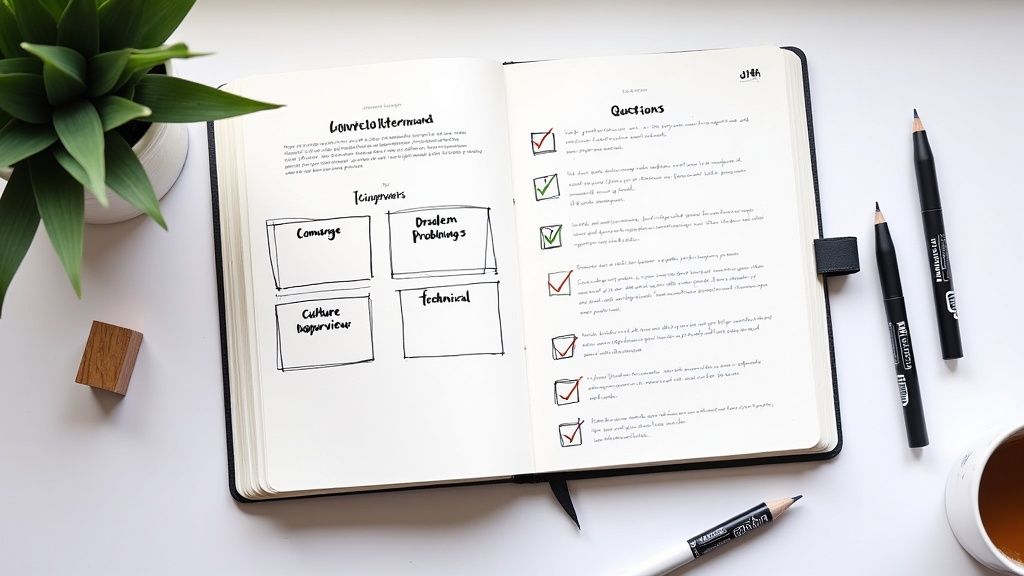
The best interview notes start with a solid foundation, not a blank page. The goal is to create a repeatable framework that keeps your evaluations consistent, fair, and laser-focused on what the role actually demands. A structured approach cuts through the noise and lets you zero in on what truly matters.
This isn't just about being organized; it's about making better hires. Systematic note-taking significantly improves post-interview evaluations. For instance, studies have shown that the number of job-related skills documented in an interviewer's notes directly correlates with better job performance and lower employee turnover. It’s clear proof that putting in the work upfront pays off.
Deconstruct the Job Description
First things first: break down the job description into 3-5 core competencies. These are the absolute must-haves for anyone to succeed in the role.
- Technical Skills: Get specific. What software, programming languages, or methodologies are non-negotiable? Think Python, Salesforce, or Agile.
- Behavioral Traits: What are the soft skills that make or break someone on your team? This could be collaboration, problem-solving, or clear communication.
- Cultural Contribution: What values or work styles are essential for thriving in your company's environment?
With these competencies defined, you can craft open-ended questions that get to the heart of their experience. Instead of a simple "Are you a team player?" try something more revealing, like, "Tell me about a time a project hit a major snag. How did you and your team work together to get it back on track?"
A well-designed framework turns an interview from a simple conversation into a data-gathering exercise. Your notes become the raw data, and a clear structure ensures that data is clean, relevant, and easy to compare across candidates.
Choose Your Tools Wisely
Your note-taking tool should feel like an extension of your workflow, not a distraction. For some, a classic pen and notebook is perfect for jotting down impressions without a screen creating a barrier. For others, a digital tool offers superior organization and searchability. If you’re looking for ideas, we’ve put together some great note-taking examples for different situations.
It also helps to have a solid grasp of the bigger picture, and understanding how to conduct effective interviews will naturally make your note-taking more impactful.
Finally, if you plan to record the conversation, always ask for permission first. A simple, professional request works best: "To make sure I capture all the important details accurately, would you be comfortable if I record our conversation for my notes?" It’s a small gesture that builds trust and shows respect for the candidate.
Capturing Key Details During the Interview
Once the interview starts, the real challenge isn't just asking questions; it's listening—really listening. Your goal is to find a flow that lets you jot down the important stuff without losing your connection with the candidate.
Think of it this way: you're not just a stenographer. You're a detective gathering evidence. Every note you take should help you answer one simple question: "Can this person actually do the job we need them to do?" This means you need a system to quickly capture skills, real-world examples, and anything that makes you pause.
Find a Shorthand That Works for You
Forget writing full sentences—you'll fall behind in seconds. The key is developing a personal shorthand that lets you keep up with the conversation. This doesn't have to be complicated; it just has to be consistent so you can fairly compare notes between candidates later.
Your system should feel like second nature.
Here are a few ideas that work well in practice:
- Who's Talking? Use
C:for the candidate andI:for you (the interviewer). It's a lifesaver when you're trying to make sense of your notes later. - Tag the Skills: Abbreviate the core skills you're hiring for. If you need a great project manager, tag relevant answers with
PM. If team collaboration is crucial, useTC. This immediately connects their answers to your needs. - Flag the Big Moments: Simple symbols are your best friend. A star (
*) for a killer answer, a plus sign (+) for a clear strength, a minus sign (-) for a concern, and a question mark (?) for something you need to circle back on.
Suddenly, your notes go from a messy block of text to a structured, scannable record. A quick note might look something like this:
C: Led a team of 5 on the Zeta project (PM*). Mentioned friction with another team but fixed it with weekly syncs (TC+). A little fuzzy on the budget details (?).
Stick to the Facts, Not Just Feelings
This is where most interviewers trip up. It's so easy to let our biases sneak into our notes. We write down "seemed nervous" instead of what actually happened: "spoke quickly, avoided eye contact when discussing project budget." The first is a judgment call; the second is a fact.
A great way to avoid this trap is to literally draw a line down your page (or create two columns in your document). One side is for what you heard, and the other is for what you thought.
Capturing direct quotes is a game-changer. It anchors your feedback in reality, not just a vague "gut feeling." When you debrief with your team, you can say, "The candidate said, 'XYZ'," which is far more powerful and credible than, "I just got a weird vibe."
This disciplined method forces you to base your evaluation on concrete evidence. I also like to timestamp crucial moments (e.g., adding 14:32 next to a key answer). If you're recording the call, it makes it incredibly easy to jump right back to that exact spot to double-check what was said. This helps ensure your final decision is as fair and evidence-backed as possible.
Turning Raw Notes into Actionable Insights
https://www.youtube.com/embed/TI3l_utdx1s
The interview isn’t really over when you hang up the call or shake hands. In many ways, the most important work is just beginning. Now, you have to turn that jumble of raw notes and fleeting impressions into a clear, objective tool that will help you make a smart hiring decision. It’s a step too many people rush, leading to decisions based on a gut feeling rather than solid evidence.
A critical piece of advice is to process your notes as soon as you possibly can, ideally within the first hour after the interview. The conversation is still fresh in your mind, and you can easily recall the context behind a cryptic note. If you wait a day, or even a few hours, memory fade is a real thing, and your notes lose a ton of their value.
Think of the whole process in three simple, connected stages: you listen, you capture, and then you separate fact from feeling.
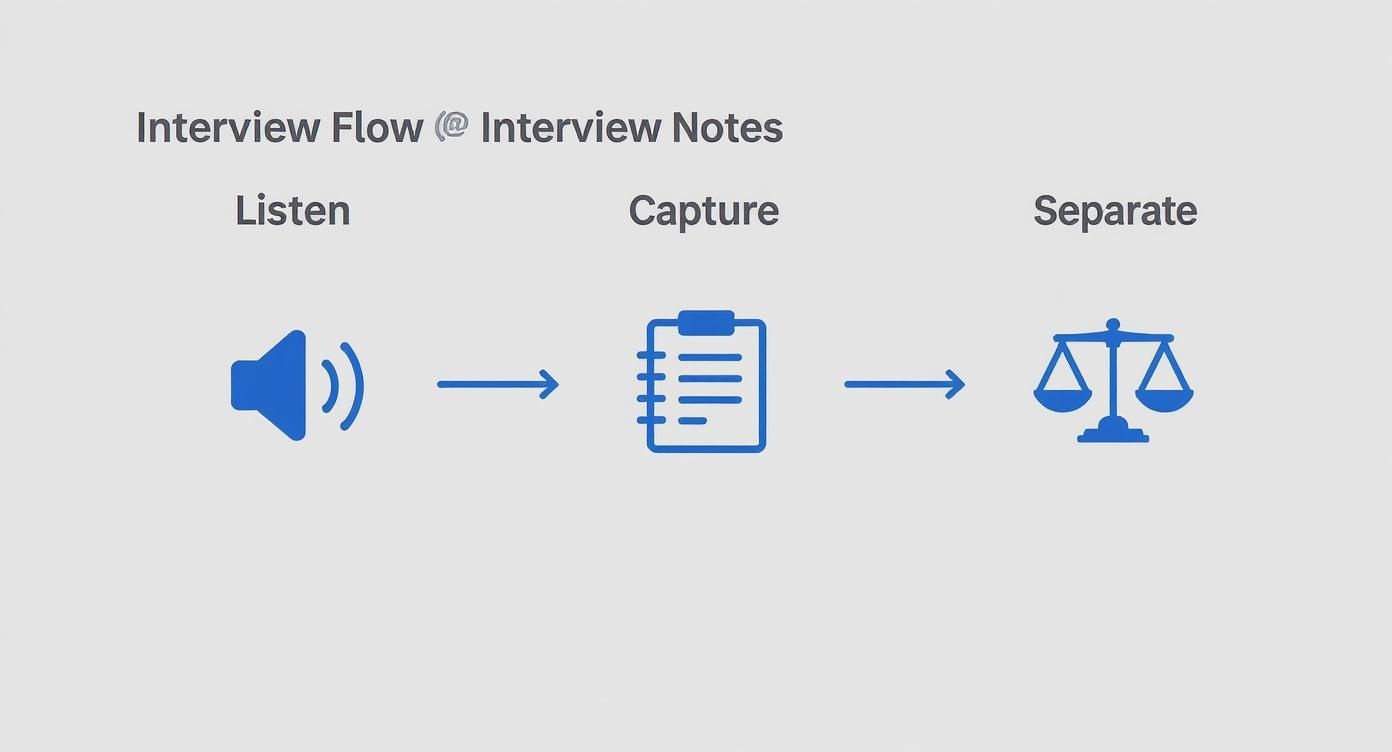
This little flow shows why it’s so critical to keep what you observed separate from what you interpreted while you're still in the interview. That separation is what allows for a fair, unbiased review later on.
Clean Up and Structure Your Notes
First things first: translate your own shorthand. Your initial goal is to turn your abbreviations and half-formed sentences into something coherent. Flesh out those bullet points and add any immediate context you remember but didn't have a chance to jot down. The test is simple: could someone else (or you, in two weeks) understand these notes?
I’ve found the best way to do this is to organize everything around the core competencies or skills you were evaluating in the first place.
- Group related points: Drag all the notes related to "Project Management" or "Team Collaboration" under those specific headings.
- Highlight key evidence: Put a star or bold the most powerful examples the candidate gave that back up a particular skill.
- Note red flags or gaps: Make a separate note of any questions the candidate dodged or areas where their answers felt weak.
Doing this transforms a chaotic, chronological transcript into a thematic document you can actually use for evaluation.
The most valuable notes are those that clearly link a candidate’s specific answer back to a job requirement. This creates an evidence-based trail that justifies your final decision and drastically reduces hiring bias.
Synthesize and Summarize Your Observations
With your notes cleaned up and organized, it's time to distill them. This isn't about rewriting everything; it's about creating a high-level summary. For each core skill, try to write just one or two sentences that capture the candidate's strengths and weaknesses, making sure to reference a specific example or direct quote from your notes.
This is where you connect the dots. Instead of a vague note like "good communicator," your summary should read more like: "Strong communicator; clearly articulated the project's technical challenges to a non-technical stakeholder using the 'X project' example."
If you have extensive notes, you can find a good walkthrough in this AI PDF Summarizer Guide that shows how to boil down dense information. This systematic approach is a cornerstone of learning how to analyze interview data fairly and consistently across multiple candidates.
Finally, armed with your structured summary, you can score the candidate against the rubric you created beforehand. By assigning a number (say, 1-5) to each competency, you create a standardized, quantifiable record. This makes it infinitely easier to compare candidates objectively and defend your hiring choice to the rest of the team.
To ensure you're consistent every time, here's a simple checklist you can follow.
Post-Interview Note Processing Checklist
This checklist helps you turn raw notes into a standardized, unbiased evaluation tool after every single interview.
By following these steps, you build a reliable system that not only helps you make better hiring decisions but also creates a defensible record of your evaluation process.
Using Technology for Smarter Note-Taking
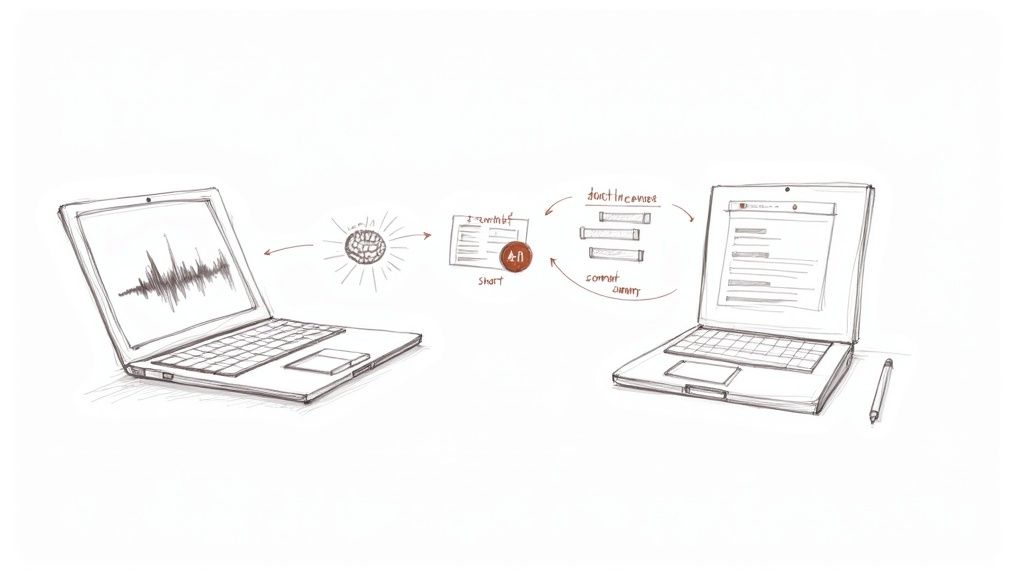
As interviews have shifted to remote and hybrid formats, the way we take notes needs to evolve, too. Technology is no longer just a nice-to-have; it's essential for capturing information accurately and working more efficiently. The right tools can handle the tedious parts of documentation, which lets you stay present and focus on what truly matters: the conversation with the candidate.
Online interviews are now a standard part of the hiring process for the vast majority of companies. This shift has created a huge need for better tools, especially transcription software, which can now capture conversations with up to 98.86% accuracy.
Automate Transcription for Perfect Recall
If there's one piece of tech that has completely changed the game for interview notes, it’s automated transcription. Forget trying to furiously type every word and missing half the context. With transcription, you get a complete, verbatim record of the entire interview.
AI-driven services take your audio or video file and turn it into a searchable text document in minutes. Suddenly, you have a single source of truth you can go back to. No more second-guessing what someone said or relying on a shaky memory.
Think of the transcript as your raw material. It’s the perfect foundation for building a solid, unbiased assessment. This is especially helpful in panel interviews, as it guarantees everyone on the hiring team is on the same page, working from the exact same information.
From Transcript to Insights with AI Summarization
A full transcript is a fantastic start, but the real magic happens when you use AI to pull insights from it. Today’s tools go way beyond simple speech-to-text. They can sift through the entire conversation and deliver a concise summary, highlighting the most important themes.
It's like having a research assistant who’s already done the initial review for you. The AI can pull out key topics, repeated keywords, and even flag sentiment, giving you a bird's-eye view without you having to re-read every single word.
This lets you quickly spot crucial details, such as:
- Key Skills and Experiences: The AI can instantly highlight every instance the candidate mentioned a specific skill, like "project management" or "data analysis."
- Action Items: Did you promise to send a follow-up document? The AI can catch those commitments and list them out for you.
- Candidate Questions: It can also compile a list of all the questions the candidate asked, which offers a great window into their priorities and what they’re genuinely curious about.
This process is a massive time-saver after the interview wraps up. If you're looking to bring this into your workflow, our guide on the best interview transcription software can help you find a tool that fits your needs. The right technology doesn’t replace your judgment—it enhances it, allowing you to make smarter hiring decisions backed by comprehensive data instead of just hurried notes.
Note Templates and Real-World Examples
Consistency is the absolute bedrock of a fair and effective hiring process. It's simple, really: when you evaluate every single candidate against the same criteria, you start making decisions based on solid evidence, not just a gut feeling.
This is where a standardized template becomes your most valuable ally. It gets everyone on the same page, ensuring every interviewer knows exactly how to take interview notes that are actually useful and comparable later on.
A good template isn't just a blank page with a few headings. It's a strategic guide. It should align directly with the core competencies you pulled from the job description, creating a clear, unmissable link between what the role demands and what you’re asking the candidate. This structure naturally pushes you to dig for specific examples during the conversation.
Think of it like this. You wouldn't judge a film by just asking, "So, what did you think?" You’d have a mental scorecard for the cinematography, acting, and plot. A template does the same for your interview, giving you a much clearer, more defensible reason for your final call.
Moving From Vague Feelings to Concrete Evidence
The single biggest mistake interviewers make is jotting down subjective feelings instead of objective facts. Notes like "good communicator" or "seemed confident" are completely useless when you get to the debrief. Why? Because they can't be challenged or compared. My definition of a "good communicator" might be wildly different from yours.
Truly effective notes are packed with evidence. They capture specific actions, outcomes, and direct quotes that actually demonstrate a skill. This is the crucial shift you need to make—moving from subjective impressions to objective data. It's about documenting the how and the what, not just your overall vibe.
The goal of a great note template is to force you to be an evidence collector. It prompts you to capture details that directly prove or disprove a candidate's ability to handle the job's core responsibilities.
For example, instead of writing "not a team player," an evidence-based note looks like this: "When asked about team conflict, used 'I' and 'me' exclusively. Mentioned having to 'fix' a colleague's work but didn't discuss collaboration." See the difference? That's a specific observation the entire hiring team can discuss and evaluate together.
Vague vs. Evidence-Based Note-Taking Examples
Seeing the difference in action really makes the concept click. Vague notes are easy to scribble down in the moment, but they create a ton of confusion later. Evidence-based notes require more discipline, but they give you a rock-solid foundation for making the right hire.
The table below shows exactly how to transform those fuzzy, subjective notes into objective evidence that drives better decisions.
This comparison highlights the power of specificity. By focusing on concrete examples and even quoting the candidate, you build a rich, detailed picture of their capabilities. This approach doesn't just make your debriefs more productive—it makes your final hiring decisions far more reliable.
Frequently Asked Questions About Interview Notes
Even the most seasoned interviewers know that things can get a little messy. The real world rarely fits into a neat template, and knowing how to handle those curveballs is what separates a good interviewer from a great one. Let’s tackle some of the most common questions about taking notes in those dynamic, sometimes unpredictable, hiring conversations.
How do I take notes in a panel interview?
Panel interviews can feel chaotic. With questions coming from multiple directions, it's easy to get overwhelmed trying to write everything down. The secret here isn't to write faster; it's to divide and conquer.
Before the candidate even walks in, huddle with your fellow panelists and assign a clear focus to each person.
- Panelist 1: Zeros in on the candidate's technical skills and hands-on experience.
- Panelist 2: Listens for answers to behavioral questions and assesses their potential contribution to the team's culture.
- Panelist 3: Takes on the role of the "scribe," focusing on capturing standout quotes, general observations, and the overall flow of the conversation.
This way, everyone isn't just duplicating the same notes. It frees up each interviewer to be more present and engaged. After the interview, you can all pool your notes into a shared document, creating a much richer, more comprehensive picture of the candidate.
Are there legal issues to consider when taking interview notes?
Absolutely. This is a big one. Think of your interview notes as official hiring documents, because that's exactly what they are. In the unfortunate event of a discrimination claim, they can be subject to legal review. That means you need to keep them professional, objective, and tied directly to the job requirements.
Never write down notes about a candidate's personal life or characteristics protected by law. This includes things like their age, marital status, nationality, or physical appearance. Your notes should be a reflection of their skills and experience as they relate to the job, and nothing more.
Always ground your notes in evidence, not a "gut feeling." For instance, instead of writing "didn't seem very confident," you should document a specific, observable behavior: "Avoided eye contact when discussing leadership experience and used hesitant language." Sticking to the facts is your best defense.
What if I realize I missed something important?
It happens to all of us. You’re deep in conversation, the flow is great, and then you realize you completely forgot to ask a key follow-up or didn't quite grasp an answer. Don't sweat it.
If you catch it while the interview is still going, it's completely okay to say, "You know, I’d love to circle back to what you said about [specific project]. Could you tell me a bit more about that?" It actually shows you're engaged and paying close attention.
And if you don't realize it until after they've left? Just address the gap in a follow-up email or make a note to cover it in the next interview round. It’s not a big deal.
Ready to make your note-taking process faster and a whole lot smarter? Let Whisper AI take transcription and summarization off your plate so you can focus 100% on the candidate. Get started with Whisper AI today and start turning your interviews into clear, actionable insights.
